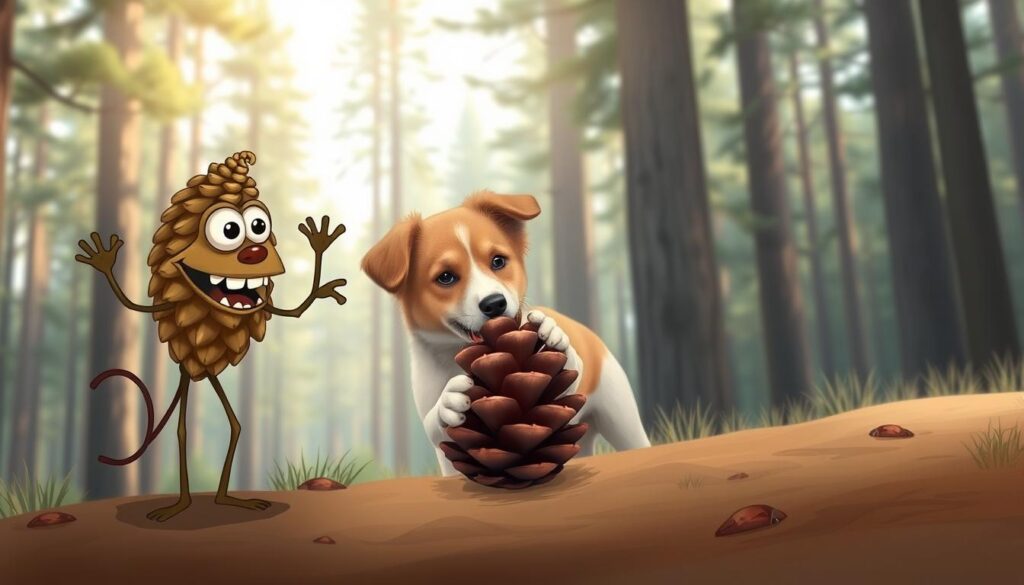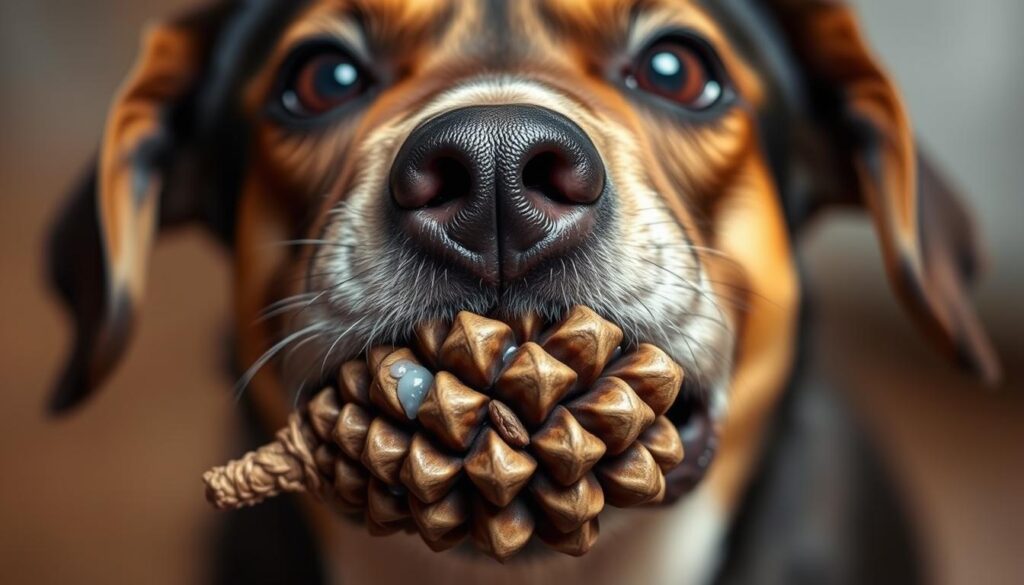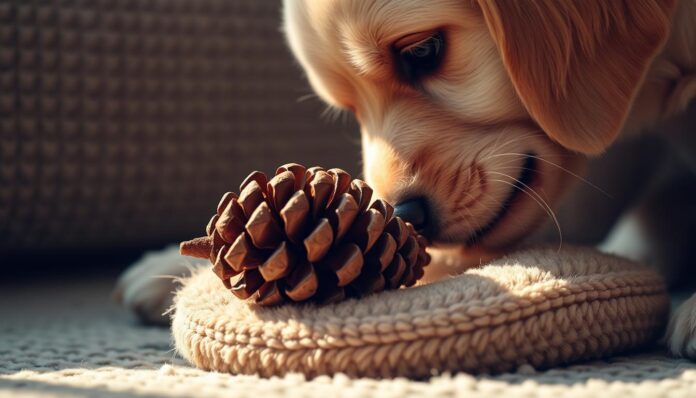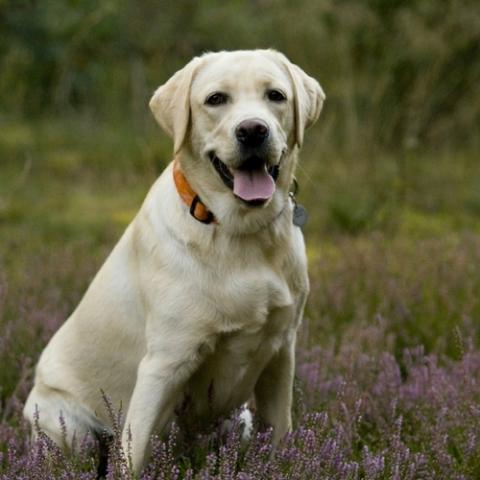Did you know that over 60% of pet owners are unaware of the hidden dangers lurking in their backyard? Pine cones, while seemingly harmless, can pose unexpected risks to our furry friends. At Top Dog Retrievers, we’ve been providing trusted pet health advice since 2012, and we’re here to guide you through this important topic.
Though pine cones aren’t toxic, they can cause serious health issues if ingested. From choking hazards to intestinal blockages, it’s crucial to understand the risks. This article will provide vet-approved answers and practical tips to keep your pet safe.
We’ll cover the immediate reactions to watch for, prevention methods, and how to handle emergencies. Our goal is to ensure every pet parent feels informed and ready to protect their beloved companion. Let’s dive in and explore what you need to know about pine cones and your pet’s health.
Understanding the Risks of Pine Cone Ingestion
Many pet owners overlook the hidden dangers of backyard items like pine cones. While they may seem harmless, these natural objects can lead to significant health issues. Let’s explore the risks in detail to help you keep your pet safe.
Gastrointestinal Upsets and Irritation
Ingesting a pine cone can cause mild to severe stomach discomfort. The rough texture and sharp needles can irritate the digestive tract, leading to symptoms like vomiting, nausea, and constipation. Even a small piece can trigger these reactions.
Pine sap, often found on cones, can also upset the stomach. If your pet shows signs of discomfort, such as lethargy or loss of appetite, it’s essential to monitor them closely. Early detection can prevent more serious complications.
Serious Blockage Concerns
One of the most critical risks is intestinal blockage. Pine cones are not easily digestible and can get stuck in the digestive system. This condition is life-threatening and often requires surgical intervention to remove the obstruction.
Signs of a blockage include persistent vomiting, abdominal pain, and inability to pass stool. If you notice these symptoms, contact a veterinarian immediately. Timely action can save your pet’s life.
Remember, even non-toxic items like pine cones can be dangerous due to their physical properties. Always keep an eye on your pet during outdoor adventures to prevent accidental ingestion.
can dogs eat pine cones? Myth vs. Fact
When it comes to backyard safety, many pet parents have misconceptions about what’s truly safe for their furry companions. Pine cones, for example, are often misunderstood. Let’s separate fact from fiction to ensure your pet stays healthy and happy.

Myth: Pine cones are natural, so they’re safe for pets to chew on.
Fact: While they’re non-toxic, their rough texture and sharp edges can cause serious harm. Ingestion can lead to stomach irritation or even life-threatening blockages.
Myth: If my pet nibbles on a pine cone, it’s no big deal.
Fact: Even small pieces can trigger digestive issues like vomiting or constipation. It’s always better to prevent access to these items altogether.
Many pet owners believe that natural objects in their yard are harmless. However, items like pine cones can pose hidden dangers. Understanding the truth helps you take proactive steps to protect your pet.
For more tips on keeping your pet safe, check out our guide on pet care choices. Being informed is the first step toward ensuring your furry friend’s well-being.
What Happens When Dogs Ingest Pine Cones
Pine cones may seem harmless, but their ingestion can lead to serious health complications for pets. Understanding the immediate and long-term effects is crucial for every pet parent. Let’s break down what to expect and how to respond effectively.

Immediate Reactions and Symptoms
When a pet swallows a pine cone, the first signs often appear within 30 minutes to 2 hours. Common symptoms include vomiting, drooling, and mild mouth irritation. The rough texture and sharp edges can cause discomfort, leading to excessive drooling or pawing at the mouth.
In some cases, the sap on the cone can irritate the digestive tract, causing nausea or loss of appetite. If you notice these signs, monitor your pet closely. Early detection can prevent more severe complications.
Potential Long-Term Health Effects
If left untreated, pine cone ingestion can lead to serious conditions like intestinal blockage. This occurs when the cone or its fragments get lodged in the digestive system, preventing normal function. Symptoms include persistent vomiting, abdominal pain, and inability to pass stool.
In severe cases, surgical intervention may be necessary to remove the obstruction. Delayed treatment can result in long-term damage to the digestive tract. Always consult a veterinarian if you suspect your pet has ingested a pine cone.
| Symptom | Action |
|---|---|
| Vomiting | Monitor closely, contact vet if persistent |
| Drooling | Check for mouth irritation, offer water |
| Abdominal Pain | Seek immediate veterinary care |
| Inability to Pass Stool | Emergency vet visit required |
For more digestive health tips, explore our comprehensive guide. Being informed helps you take proactive steps to protect your furry friend.
Preventing Pine Cone Mishaps During Outdoor Adventures
Outdoor adventures with your furry friend can be fun, but they also come with hidden risks. One of the most overlooked dangers is the temptation for pets to pick up or chew on pine cones. With the right training and precautions, you can ensure your pet stays safe while enjoying nature.
Effective Training Techniques
Training your pet to avoid pine cones starts with simple commands like “leave it” and “drop it.” These commands are essential for redirecting their attention away from potentially harmful objects. Use positive reinforcement, such as a treat or praise, to reward them for obeying.
Consistency is key. Practice these commands during daily walks or playtime. Over time, your pet will learn to associate leaving objects alone with positive outcomes. This approach not only keeps them safe but also strengthens your bond.
Another effective strategy is to carry a favorite toy or treat as a distraction. If your pet shows interest in a pine cone, redirect their focus to the toy or reward. This helps reinforce the idea that ignoring the cone leads to something better.
For more detailed training tips, check out our guide on chewing behaviors in puppies and adult. Prevention is always better than cure, and with patience, you can create a safer outdoor experience for your furry companion.
Expert Insights for Safe Pet Parenting
Keeping your pet safe requires more than just love—it demands expert guidance. At Top Dog Retrievers, we’ve collaborated with trusted veterinarians since 2012 to provide actionable advice for pet parents. Their insights help us create a safer environment for your furry companions, both at home and during outdoor adventures.
Tips from Our Trusted Veterinarian Partners
Our network of veterinary professionals emphasizes the importance of proactive measures. Here are some of their top recommendations:
- Training Commands: Teach your pet commands like “leave it” and “drop it” to prevent them from picking up harmful objects. Positive reinforcement, such as a treat or praise, makes this training effective.
- Safe Playtime: Always supervise outdoor activities, especially in areas with natural debris like pine cones. Carry a favorite toy or treat to redirect their attention if needed.
- Regular Check-Ups: Schedule routine visits to the vet to monitor your pet’s health and address any concerns early.
One of our partners shared a success story about a pet who learned to avoid dangerous items through consistent training. “It’s about creating habits that keep them safe,” they explained. This approach not only protects your pet but also strengthens your bond.
| Tip | Benefit |
|---|---|
| Use Positive Reinforcement | Encourages good behavior without fear |
| Supervise Outdoor Play | Prevents accidental ingestion of harmful objects |
| Schedule Regular Vet Visits | Ensures early detection of health issues |
For more detailed guidance on creating a safe environment, explore our resources on pet health. Expert insights are central to sound pet care practices, and we’re here to support you every step of the way.
Emergency Steps and When to Seek Vet Help
Accidents can happen, and knowing how to respond when your pet ingests something harmful is crucial. If you suspect your furry friend has swallowed a pine cone, acting quickly can make all the difference. Here’s what you need to know to handle the situation effectively.
Recognizing Warning Signs
Early detection is key to preventing serious complications. Watch for symptoms like vomiting, diarrhea, or lethargy. These could indicate that a pine cone piece is causing irritation or blockage in the digestive system.
Other signs include abdominal pain, loss of appetite, or difficulty passing stool. If your pet shows any of these symptoms, it’s time to take action. Monitoring their behavior closely can help you determine the severity of the situation.
Immediate Actions to Take
If you notice warning signs, the first step is to stop your pet from eating anything else. Offer water to keep them hydrated but avoid feeding them until you’ve consulted a professional.
Contact your veterinarian immediately. Provide details about what your pet may have ingested and the symptoms they’re experiencing. Quick communication can help the vet decide the next steps.
Overview of Possible Veterinary Procedures
In severe cases, your vet may recommend imaging tests like X-rays or ultrasounds to locate the obstruction. If the pine cone piece is stuck, procedures like endoscopy or surgery might be necessary to remove it.
Early intervention increases the chances of a successful outcome. Delayed treatment can lead to life-threatening complications, so don’t hesitate to seek professional help.
For more information on keeping your pet healthy, explore our guide on dog nutrition. Being prepared ensures you can act swiftly in emergencies, protecting your beloved companion.
Wrapping Up Our Vet-Guided Pet Health Journey
Protecting your furry companion from hidden dangers like pine cones is a vital part of responsible pet parenting. Throughout this article, we’ve explored the risks, symptoms, and preventive measures to ensure your pet stays safe. Understanding these hazards helps you create a secure environment for your beloved friend.
Training your pet to avoid harmful objects and supervising outdoor activities are key steps. Consistent commands like “leave it” and “drop it” can make a significant difference. Additionally, staying vigilant during walks or playtime reduces the chances of accidental ingestion.
If an emergency arises, knowing the warning signs and acting quickly is crucial. Symptoms like vomiting or abdominal pain require immediate attention. Always consult a professional to address any concerns promptly.
At Top Dog Retrievers, we’re committed to providing trusted advice to keep your pet healthy and happy. For more tips on pet safety, explore our guide on managing curious behaviors. Together, we can ensure your furry friend enjoys a safe and joyful life.

















